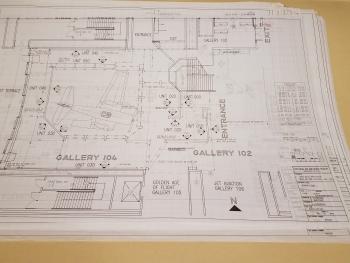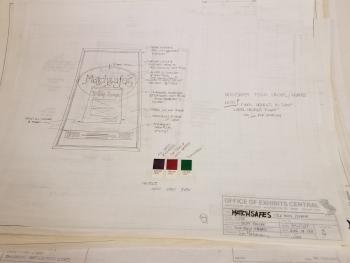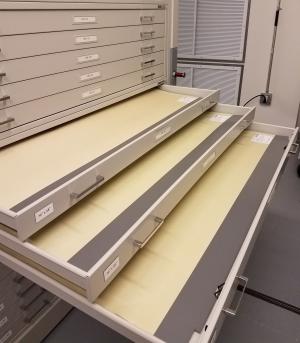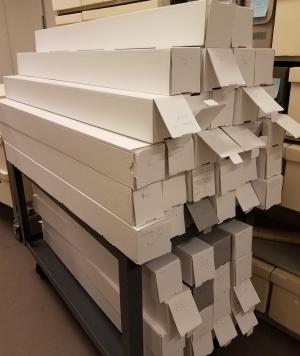Many offices across the Smithsonian transfer collections to the Smithsonian Institution Archives when they have run out of space to store their records. Over the last decade, there has been a noticeable increase in the amount of large flat files transferred to the Archives. Many of these files primarily consist of exhibition drawings.

Generally, these drawings are architectural in nature, computer-generated or hand-drawn, and document the design and specifications of exhibit spaces. They may give an overview of the space prior to exhibit installation, show the architectural elements of the installed exhibit from various angles, or provide details of specific elements of the design. These drawings often note dimensions, fonts, colors, object placement, and other information related to the installation. The architectural drawings typically include an information block which includes the museum, the exhibit name or gallery location, designer, project number, and date of the drawing.

In addition, exhibition drawings will often include hand-drawn or hand-painted concept sketches. These are typically created prior to the detailed design, and illustrate the designer’s idea for the overall look of the exhibit. These drawings may depict the entrance to the space, a highlight of the exhibit, or “typical” aspects of the exhibit such as a recurring design theme.
The physical transfer of these exhibition drawings, or any large flat files, is often challenging. Many museums have accumulated their drawings over the course of decades and find their storage drawers overflowing. Those drawings stacked near the top of the pile are often at risk of tearing when opening a drawer. As new flat files are added, older drawings may be smashed and crinkled or slip behind the drawers.

We often try to partially rehouse the drawings during the physical transfer and have an important decision to make. Will the drawings ultimately be stored flat in the Archives’ limited drawer space or rolled and stored in tubes? This decision is based upon the fragility and size of the drawings. Fragile or torn paper, extremely stiff paper or board, drawings with glued materials, and small or mixed-size drawings will be stored flat. Meanwhile, architectural drawings on paper that was intended for heavy use can be rolled without significant long-term preservation issues.
Drawings are sorted by exhibit to the extent possible during transfer and placed in labeled folders or tubes. Given the sheer volume of drawings that are often transferred, the process can take multiple days and require coordination with a number of staff from both the transferring museum and the Archives. Working space is needed at the museum and a clear, wide path to the loading dock is necessary. Several staff may be required to maneuver the materials into the van.

Once the drawings have physically arrived at the Archives, they still need to be processed. Oftentimes, drawings for different exhibitions are mixed together in the same drawer and, other times, drawings for the same exhibition are spread across several drawers. This requires additional sorting upon arrival at the Archives. Some drawings are missing key information and must be identified. Certain drawings may be separated for conservation work or for storage elsewhere due to their size or fragility. Drawings placed in tubes for transfer are unpacked, their contents adjusted to an optimum thickness, and then rerolled onto cores before placing them back in the tubes. Descriptive information about the drawings, including the full title and dates of each exhibition, is created or updated.
Unfortunately, processing exhibition drawings, or other large drawings, maps, or posters, may not happen until well after the materials have been physically transferred to the Archives. A large, unorganized transfer could take days and an enormous amount of table space to process. These projects require staff to dedicate significant, uninterrupted time to processing the materials as well as to coordinate schedules with volunteers, interns, and other staff for use of table space. In a busy archives, this can be the biggest challenge of them all!
Related Collections
- Collections with exhibition drawings, Smithsonian Institution Archives
Related Resources
- "The Squeaky Wheel Gets the Grease: A Custom Storage Solution for an Unusual Collection," by William Bennett, The Bigger Picture, Smithsonian Institution Archives
- "Pennywise Preservation: Oversized Prints and Drawings," by Alison Reppert Gerber, The Bigger Picture, Smithsonian Institution Archives
- "Records Shed Light on How Exhibitions Come to Life," by Lynda Shmitz Fuhrig, The Bigger Picture, Smithsonian Institution Archives
- "How the Archives Gets its Records (or, Golden Lion Tamarins Galore)," by Jennifer Wright, The Bigger Picture, Smithsonian Institution Archives
Produced by the Smithsonian Institution Archives. For copyright questions, please see the Terms of Use.

Leave a Comment